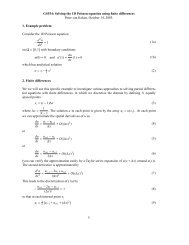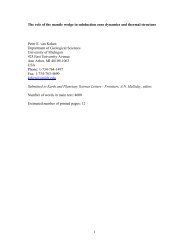Quantitative paleoenvironmental and paleoclimatic reconstruction ...
Quantitative paleoenvironmental and paleoclimatic reconstruction ...
Quantitative paleoenvironmental and paleoclimatic reconstruction ...
You also want an ePaper? Increase the reach of your titles
YUMPU automatically turns print PDFs into web optimized ePapers that Google loves.
ARTICLE IN PRESS<br />
32 N.D. Sheldon, N.J. Tabor / Earth-Science Reviews xxx (2009) xxx–xxx<br />
with low diffusivity occur only a few centimeters below the soil<br />
surface, whereas low productivity soils with high diffusivity have<br />
much deeper characteristic production depths, possibly as deep as 30–<br />
50 cm below the soil surface (Wood <strong>and</strong> Petraitis, 1984; Quade et al.,<br />
1989; Cerling <strong>and</strong> Quade, 1993; Yapp <strong>and</strong> Poths, 1992 Schroeder <strong>and</strong><br />
Melear, 1999). Furthermore, soil media with lower diffusivity will be<br />
characterized by higher S(z) values than low diffusivity counterparts.<br />
Moreover, due to variations in productivity of soil biota, soils from<br />
warm climates will have higher S(z) values than cool climate counterparts,<br />
<strong>and</strong> soils with abundant soil moisture will have higher S(z)<br />
values than their drought-phase counterparts. For example, Breecker<br />
et al. (2009) have recently monitored S(z) values for modern semiarid<br />
soils in New Mexico <strong>and</strong> found that there was significant seasonal<br />
variation between about 500 <strong>and</strong> 2000 ppmv, which was in turn<br />
reflected by seasonal variations in δ 13 C <strong>and</strong> δ 18 O. Pedogenic carbonate<br />
formation occurred simultaneously with S(z), δ 13 C, <strong>and</strong> δ 18 O minima,<br />
which suggests that the carbonate is not recording mean growing<br />
season conditions <strong>and</strong> that there is therefore a seasonal bias in the<br />
formation of pedogenic carbonates.<br />
Although modern 2-component soil CO 2 concentrations range from<br />
little more than ambient tropospheric concentrations (~500 ppmV;<br />
Wood <strong>and</strong> Petraitis, 1984) to as much as 21% of the soil atmosphere<br />
(210,000 ppmV; Yamaguchi et al., 1967; Brook et al., 1983), soils that<br />
are characterized by mixing of two soil CO 2 components, <strong>and</strong> which<br />
contain in situ accumulations of calcite, appear to be limited to a range<br />
of soil CO 2 concentrations from about 1000–8000 ppmV (de Jong <strong>and</strong><br />
Schappert, 1972; Brook et al., 1983; Wood <strong>and</strong> Petraitis, 1984; Soloman<br />
<strong>and</strong> Cerling, 1987; Quade et al., 1989). This range of soil CO 2 concentrations<br />
reflects the relatively low productivity of soils characterized<br />
by calcite crystallization (Schlesinger, 1997). Note however, that<br />
this very low range of soil pCO 2 also reflects that modern tropospheric<br />
pCO 2 is low, <strong>and</strong> contributes very little (~300 ppmV) to total soil pCO 2 .<br />
For times when tropospheric pCO 2 was significantly higher than<br />
modern (e.g., 2000–3000 ppmV; Eocene, Paleocene, Cretaceous; Yapp<br />
<strong>and</strong> Poths, 1996; Yapp, 2004; Tabor <strong>and</strong> Yapp, 2005a), soil CO 2 in<br />
calcareous soils likely had a correspondingly higher concentration<br />
(3000–11,000 ppmV).<br />
Ekart et al. (1999) assumed soil CO 2 concentrations of 5000 ppmV<br />
for 758 paleosol calcite samples representing ~400 million years time.<br />
Nordt et al. (2002) assumed a range of soil CO 2 concentrations from<br />
4000 to 6000 ppmV for paleosols from Upper Cretaceous <strong>and</strong> Lower<br />
Paleogene strata in Alberta, Canada. Prochnow et al. (2006) assumed<br />
soil CO 2 concentration to be 4000 ppmv for “arid to semiarid” paleosol<br />
calcite <strong>and</strong> 5000 ppmv for “subhumid” paleosol calcite samples from<br />
Triassic profiles in Utah, U.S.A. However, if the lower overall S(z)<br />
values <strong>and</strong> seasonal bias recorded in modern semi-arid soils in terms<br />
of S(z) was comparable in the geologic past, then it is likely that many<br />
of the paleoatmospheric pCO 2 estimates in the literature are overestimates<br />
(Breecker et al. (2009), so care is needed in considering<br />
records from arid to semi-arid settings.<br />
In their treatment of Permo-Carboniferous paleosols from the<br />
southwestern United States, Montañez et al. (2007) assumed that<br />
calcite samples taken from morphologies indicative of long-term net<br />
soil moisture deficiency, such as Calcisols (Mack et al., 1993), were<br />
characterized by generally low <strong>and</strong> invariant S(z) values, whereas<br />
calcites from paleosol morphologies consistent with less soil moisture<br />
deficiency, such as calcic Argillisols, were characterized by relatively<br />
high <strong>and</strong> invariant S(z) values, <strong>and</strong> calcite samples collected from<br />
paleosol morphologies that are indicative of significant variability in<br />
soil moisture availability, such as calcic Vertisols, were characterized<br />
by a larger range of S(z) values. Finally, the lithology of the paleosol<br />
profiles (s<strong>and</strong>stone, siltstone, mudstone <strong>and</strong> claystone) was assumed<br />
to have affected the soil pCO 2 . Montañez et al. (2007) used the<br />
following ranges of S(z) values for paleoatmospheric pCO 2 estimates:<br />
(1) s<strong>and</strong>stone-dominated Calcisols are lowest, ranging from 1000–<br />
3000 ppmV, (2) siltstone-dominated Calcisols range from 1500 to<br />
4000 ppmV, (3) mudstone-dominated Calcisols range from 2000 to<br />
5000 ppmV, (4) mudstone-dominated Vertisols range from 3200 to<br />
7500 ppmV, (5) claystone-dominated calcic Vertisols range from 4000<br />
to 8000 ppmV, <strong>and</strong> (6) mudstone-dominated calcic Argillisols are<br />
highest, ranging from 6000 to 9000 ppmV.<br />
The importance of the assumed soil pCO 2 values (C S values) cannot<br />
be overstated, as the resulting atmospheric pCO 2 estimates vary proportionately<br />
with them (Cerling, 1991; Ekart et al., 1999; Royer et al.,<br />
2001a,b; Tabor et al., 2004a,b). Therefore, until an independent means<br />
of estimating soil CO 2 concentration (see Section 8.1 for a possible<br />
method for this) at the time of calcite crystallization in a paleosol<br />
profile becomes available, this parameter will remain an effectively<br />
unknown value, <strong>and</strong> will continue to limit the utility of paleosol calcite<br />
δ 13 C values as proxy of atmospheric pCO 2 .<br />
Cerling (1991, 1992) were the first studies to demonstrate the<br />
potential of paleosol calcite δ 13 C values as a proxy of atmospheric<br />
pCO 2 , in which it was suggested that Cretaceous atmospheric pCO 2<br />
was significantly higher than modern values. This was followed by<br />
several important studies of Paleozoic paleosol calcites, which<br />
appeared to delineate a first-order trend of decreasing atmospheric<br />
pCO 2 from ~15–20 PAL in the Early Paleozoic to near PAL in the Late<br />
Carboniferous (Mora <strong>and</strong> Driese, 1993; Mora et al., 1996). These<br />
Paleozoic studies were especially important at the time of publication,<br />
because they were among the first geochemically-based pCO 2 proxy<br />
data for comparison with carbon mass flux model pCO 2 estimates<br />
(Berner, 1991; Berner <strong>and</strong> Kothavala, 2001), <strong>and</strong> the two different<br />
model estimates appeared to agree with one another.<br />
Ekart et al. (1999) compiled the first temporally extensive dataset<br />
of two-component paleosol calcite δ 13 C values. Ekart et al. (1999)<br />
presented results for 758 δ 13 C analyses that represented each time<br />
period since the advent of vascular plants (~400 million years BP;<br />
Fig. 19). The results of that study largely agreed with estimated<br />
paleoatmospheric pCO 2 from carbon mass flux models, but Ekart<br />
et al. (1999) also noted a significant disparity between pCO 2<br />
estimates from the two proxy methods for the Permian. There have<br />
been dozens of additional studies of paleosol calcite δ 13 Cvaluessince<br />
the compilation provided by Ekart et al. (1999). Fig. 19 presents 2615<br />
pedogenic calcite δ 13 C values (black crosses), ranging in age from<br />
Devonian to Recent (~415–0 My), which were compiled from the<br />
literature. This compilation includes results only from those studies<br />
that presented paleosol micrite δ 13 C values in a Table or Appendix<br />
(see caption in Fig. 19 for sources). Also shown in Fig. 19 are the best<br />
fit <strong>and</strong> 95% confidence interval for terrestrial vascular plant organic<br />
matter δ 13 C values that is based upon analysis of 2148 different<br />
samples, which range from Devonian to Late Cretaceous (Strauss <strong>and</strong><br />
Peters-Kottig, 2003). Because of complications related to the<br />
evolution <strong>and</strong> prominence of C 4 photosynthesizers in l<strong>and</strong>scapes<br />
characterized by soils that accumulate calcite, the following discussion<br />
is limited to pre-Cenozoic data. Furthermore, the authors<br />
emphasize that the following discussion is intended only as a<br />
demonstration of how models of 2-component soil CO 2 mixing can<br />
be applied to paleosol calcite data, <strong>and</strong> it is not intended for any<br />
specific inferences to be drawn about variations in paleoatmospheric<br />
pCO 2 .<br />
Assuming that organic matter δ 13 C values in Fig. 19 accurately<br />
represent the δ 13 C values of organic matter in the soils from which<br />
calcite δ 13 C values are derived, they can be used to define an effective<br />
lower limit for calcite δ 13 C values that are permissive of twocomponent<br />
soil CO 2 mixing. This lower limit calcite δ 13 C value (thick<br />
red line marked by 0 PAL) is 14.8‰ more positive than contemporaneous<br />
paleosol organic matter, which reflects 4.4‰ diffusive enrichment<br />
of CO 2 δ 13 C values derived from oxidation of organic matter, as<br />
well as an additional 10.4‰ carbon isotope enrichment from gaseous<br />
CO 2 to calcite due to carbon isotope fractionation between carbonate<br />
species (at mildly alkaline pH; Bottinga, 1968). Calcite δ 13 C values that<br />
are more negative than this lower limit provide negative estimates of<br />
Please cite this article as: Sheldon, N.D., Tabor, N.J., <strong>Quantitative</strong> <strong>paleoenvironmental</strong> <strong>and</strong> <strong>paleoclimatic</strong> <strong>reconstruction</strong> using paleosols, Earth-<br />
Science Reviews (2009), doi:10.1016/j.earscirev.2009.03.004















